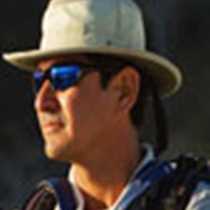Santiago Islands, otherwise known as James Island after the English name, is the fourth largest of the Galápagos Islands, with many lava flows, verdant highlands, giant tortoises and sources of fresh water inland. This features made Santiago Island one of the favorite islands of the first visitors to Galápagos. Santiago Island shows evidence of having much volcanic activity in her recent past, as demonstrated by the long stretches of black basalt lava cliffs along the coast of James Bay.
Our morning started early at Espumilla Beach, on the western coast of Santiago Island, with a wet landing at one of the archipelago’s most important marine turtle nesting areas. There were many sea turtles mating near the shore and many recent turtles tracks, from females that came to nest of this beach. Just behind the mangroves we took a loop trail inland over stony terrain, into the mature Palo Santo Forest, with lovely views from the upper part of a smaller hill. After enjoying an encounter with some immature Galapagos hawks, we returned back to the ship for breakfast. After breakfast, our ship was repositioned to Buccaneer Cove, where our guests had the chance to swim, snorkel or explore the bay by kayaking or with our glass bottom boat.
In the afternoon, and after a well-deserved lunch, we landed at Puerto Egas, where Charles Darwin landed for his longest stint on land in Galápagos. He spent nine days on this Island during his visit to Galapagos in 1835.
Here, we took a lovely walk along the shoreline, where we encountered many baby sea lions with resting their mothers. Once again, we also came upon the peculiar marine iguanas with a distinctive color, so similar to the surrounding lava. At the end of the trail, we found a small colony of fur seals in their favorite habitat—deeply carved sea-level grottos. This species where once at the border of extinction, as babies fur seals have beautiful silky and soft furs.
At around 5:30 pm it was time to go back to the ship, and we took the inland part of the loop trail, where we had the chance to see once again the Galápagos hawk and other endemic land birds.
Santiago Island, was adopted by Lindblad Expeditions In 1997. A special fund was created to support a major eradication effort to eliminate feral goats and pigs from the island and today, thanks to those efforts, the goats and pigs are completely gone.
This shows how such a positive impact can be affected by caring travelers and companies operating in such delicate and unique environments, like the Galapagos Archipelago.









